|
|
|
GOBELINS MANUFACTURE (said Goblins)
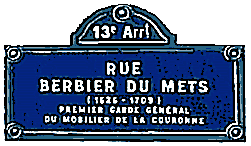 is a famous establishment of weaved tapestries and dyeing located in Paris, between the Gobelins avenue, the Croulebarbe street and the Bièvre brook.
is a famous establishment of weaved tapestries and dyeing located in Paris, between the Gobelins avenue, the Croulebarbe street and the Bièvre brook.
The "Gobelins" were a Champagne's area family originating from Reims, its capital city. In the XVth century, they was establishing a
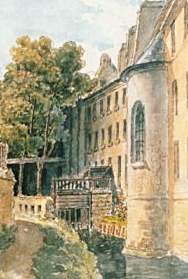 company of dye in the Saint Marceau quater in Paris; Gilles Gobelin grows rich in this industry and acquired great properties on the edges of the Bièvre,
that one called of his name "Gobelins's river" JEAN GOBLIN dyer, settled about 1440 in this green small valley where flow the Bièvre between Butte-aux-Cailles
and the Sainte-Geneviève mountain. In 1601 Henri IV installed there two Flemish tapestries makers. But it is especially Louis XIV who gave a considerable impulse
while creating in 1667 the royal manufacture of furniture of the Crown. Colbert centralized various workshops of tapestry dispersed in Paris, added workshops
of cabinet maker, of goldsmithery et cætera.
company of dye in the Saint Marceau quater in Paris; Gilles Gobelin grows rich in this industry and acquired great properties on the edges of the Bièvre,
that one called of his name "Gobelins's river" JEAN GOBLIN dyer, settled about 1440 in this green small valley where flow the Bièvre between Butte-aux-Cailles
and the Sainte-Geneviève mountain. In 1601 Henri IV installed there two Flemish tapestries makers. But it is especially Louis XIV who gave a considerable impulse
while creating in 1667 the royal manufacture of furniture of the Crown. Colbert centralized various workshops of tapestry dispersed in Paris, added workshops
of cabinet maker, of goldsmithery et cætera.
To the 18th century, the name of the Gobelins was known in the Royal court of whole Europe. The 19th century saw a part of the buildings set fire to by the
Commune revolution in 1871. It is necessary to walk round the manufacture by the street Croulebarbe and to reach the street "Berbier du Mets", to see there
building supposedly the former in the 17th century.
Manufacture continues today to produce tapestries for the "State-owned-furniture", making work of contemporary artists. But like to the origin, a workman
weaving on a trade of high wrap (the loom is vertical) make one square metre of tapestry in one year.
Tell me more
|
|
"H ôtel Royal of the Goblins".
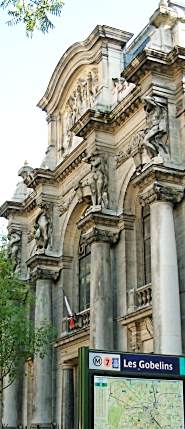 in consequence of an edict of Louis XIV. Monseigneur Colbert having restored and enriched with magnificence the palates of
the king, in particular the Louvre and Tuileries, thought of creating a manufacture for pieces of furniture suitable with the splendour of these buildings:
with this project in sight it called in all the kingdom and in the foreign nations the workmen able in various arts and art's work; in particular painters,
weavers, sculptors, goldsmiths, ébonists, et cætera. To do the establishment envisaged firm and durable, it advised the king to buy the Goblins property, so
in consequence of an edict of Louis XIV. Monseigneur Colbert having restored and enriched with magnificence the palates of
the king, in particular the Louvre and Tuileries, thought of creating a manufacture for pieces of furniture suitable with the splendour of these buildings:
with this project in sight it called in all the kingdom and in the foreign nations the workmen able in various arts and art's work; in particular painters,
weavers, sculptors, goldsmiths, ébonists, et cætera. To do the establishment envisaged firm and durable, it advised the king to buy the Goblins property, so

 that these artists can work there with their eases. It issued for their direction a system of laws, or policy, in seventeen articles. By the latter it is
regulated, that new manufacture will be under the administration of a superintendant of the "arts and buildings of the king", that in said manufacture the
ordinary Masters will be responsible for all the actions and processes brought by unspecified of the people, their servants and people in charge; that no
other work of tapestry will be imported from any other country, et cætera. The Goblins since remained the first manufacture of this kind in the world.
Quantity of finest and noblest art work which was produced by it, and numbers of the best talents which it arouses, is quite simply incredible;
the current condition of blooming of decorative arts of France is, in a great thanks, debtor to it. The work of the tapestry, in particular, is its glory.
During the superintendance of M. Colbert, and of its successor M. of Louvois, the realization of the tapestry is practised with a degree of perfection, seldom
lower than what was made by the English and in other provinces of France. Battles of Alexandre, four seasons, four elements, palates of the king, and a series
of the principal actions of the life of Louis XIV, from its first marriage to the first conquest of Franche county, conceived by M. Le Brun, director of the
manufacture of the Goblins, are master pieces in their kind.
that these artists can work there with their eases. It issued for their direction a system of laws, or policy, in seventeen articles. By the latter it is
regulated, that new manufacture will be under the administration of a superintendant of the "arts and buildings of the king", that in said manufacture the
ordinary Masters will be responsible for all the actions and processes brought by unspecified of the people, their servants and people in charge; that no
other work of tapestry will be imported from any other country, et cætera. The Goblins since remained the first manufacture of this kind in the world.
Quantity of finest and noblest art work which was produced by it, and numbers of the best talents which it arouses, is quite simply incredible;
the current condition of blooming of decorative arts of France is, in a great thanks, debtor to it. The work of the tapestry, in particular, is its glory.
During the superintendance of M. Colbert, and of its successor M. of Louvois, the realization of the tapestry is practised with a degree of perfection, seldom
lower than what was made by the English and in other provinces of France. Battles of Alexandre, four seasons, four elements, palates of the king, and a series
of the principal actions of the life of Louis XIV, from its first marriage to the first conquest of Franche county, conceived by M. Le Brun, director of the
manufacture of the Goblins, are master pieces in their kind.
Tell me more - Back
On the Gobelins avenue, the building has been buid in 1912 by Formige after the fire of 1871. It is curently now refitted to accomodate a gallery of exhibition.
|
|
T HE NATIONAL MANUFACTURES OF THE GOBELINS, BEAUVAIS & THE SAVONNERIE
Hugues Menes speaker to the manufacture of the Gobelins
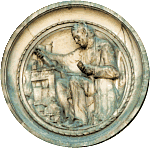
 THE GOBELINS (GOBLINS)
THE GOBELINS (GOBLINS)
It is in year 1443 that Jehan Gobelin open his workshop as dyer on the edges of the Bièvre in the Saint Marcel quater, along the pathway of Italy. Its speciality
is the dyeing in scarlet obtained with the cochineal. Its descendants will be maintained there until 1601. The workshop is then resold to some Flemish weavers:
Jean de la Planche and Marc de Comans who however will continue the activity of dyeing.
In 1662, Colbert and Louis XIV purchase the company and give it a considerable development; one estimates indeed at 250 the number of hand weavers.
The example of M. Fouquet the superintendent of finances is determining, it is indeed him who inaugurates in Maincy a tapestry workshop runing for
 its personal use with a Flemish labour. Besides Louis XIV will keep to its manufacture the weavers of Fouquet even finishing for their new lord and master the
tapestries of the superintendent. The king rebuilds the whole of the buildings which reach us today in a remarkable state of conservation in spite of work of
Haussmann in 1859 which chips the frontage of the Goblins at the time of the boring of the avenue of the same name; the Commune revolution brings its batch of
destruction but the buildings are saved of a general fire. In 1913, Formige the architect builds a gallery in frontage on the avenue of the Goblins to be used
as museum. For a few years the State has considered finally the general restoration of the work premises, residences of the weavers and museum. Thus at the
beginning of the year 2003, the workshop known as of North was re-opened to the public, presenting work of high wrap loom within the state of XVIlth century conceived
by the king. Currently, the workshop counts thirty-five lissiers (hand weavers). The production of the three departments is in the whole reserved for the need of the
state services or the diplomatic gifts.
its personal use with a Flemish labour. Besides Louis XIV will keep to its manufacture the weavers of Fouquet even finishing for their new lord and master the
tapestries of the superintendent. The king rebuilds the whole of the buildings which reach us today in a remarkable state of conservation in spite of work of
Haussmann in 1859 which chips the frontage of the Goblins at the time of the boring of the avenue of the same name; the Commune revolution brings its batch of
destruction but the buildings are saved of a general fire. In 1913, Formige the architect builds a gallery in frontage on the avenue of the Goblins to be used
as museum. For a few years the State has considered finally the general restoration of the work premises, residences of the weavers and museum. Thus at the
beginning of the year 2003, the workshop known as of North was re-opened to the public, presenting work of high wrap loom within the state of XVIlth century conceived
by the king. Currently, the workshop counts thirty-five lissiers (hand weavers). The production of the three departments is in the whole reserved for the need of the
state services or the diplomatic gifts.
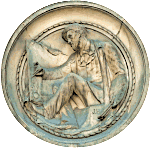
 Technique: the Goblins exclusively practise the hight wrap since 1826, the low wrap from now on being reserved for the Beauvais Manufacture. Standing up vertically,
the hight wrap loom consists of two timbering called binoculars or coterets (the Castle) which maintains two beams (rollers), that one to the bottom collecting fabric and the other to the top
accomodating the yarn reserve of wrap. The yarn of warp are separate in two tablecloths by sticks of crosswinding (also called sticks of interval).
The lissier works on the back of his work, being him self facing, across the warp, the sun light. He controls the result acroos the wrap using a mirror.
He must turn over to see back to him its paperboard (carton or model). Each yarn of warp of the back tablecloth (compared to the weaver) is provided with a
heddle (cotton cord which makes the turn of it) and makes it possible to bring back to front this back tablecloth; the front tablecloth remains fixed.
Provided with a pin (or shuttle) the lissier (hand weaver) introduces his weftthreads between yarn of warp then brings ahead the backtablecloth before
Technique: the Goblins exclusively practise the hight wrap since 1826, the low wrap from now on being reserved for the Beauvais Manufacture. Standing up vertically,
the hight wrap loom consists of two timbering called binoculars or coterets (the Castle) which maintains two beams (rollers), that one to the bottom collecting fabric and the other to the top
accomodating the yarn reserve of wrap. The yarn of warp are separate in two tablecloths by sticks of crosswinding (also called sticks of interval).
The lissier works on the back of his work, being him self facing, across the warp, the sun light. He controls the result acroos the wrap using a mirror.
He must turn over to see back to him its paperboard (carton or model). Each yarn of warp of the back tablecloth (compared to the weaver) is provided with a
heddle (cotton cord which makes the turn of it) and makes it possible to bring back to front this back tablecloth; the front tablecloth remains fixed.
Provided with a pin (or shuttle) the lissier (hand weaver) introduces his weftthreads between yarn of warp then brings ahead the backtablecloth before
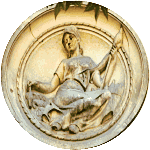
 carrying out the return of the weft. He thus will completely cover the wrap with the weft, what is the essential characteristic of a tapestry or fabric
for purpose of weft aspect. Far from being a simple underling, the lissier is thus a real artist who interprets the paperboard (the carton) provided by
the artist cartonnier.
carrying out the return of the weft. He thus will completely cover the wrap with the weft, what is the essential characteristic of a tapestry or fabric
for purpose of weft aspect. Far from being a simple underling, the lissier is thus a real artist who interprets the paperboard (the carton) provided by
the artist cartonnier.
BEAUVAIS
Founded in 1664 in the town of Beauvais, manufacture answers at this time to the private requests of kind of product same as those in the style of the king;
it also competes, situated in the cutting road of Paris, with the Flemish imports. Very brilliant, the production specializes at the XVIIIth century in furnishing
fabrics, smaller, as seat covering, and thus easier to sell out. Manufacture then uses mainly the low wrap, faster and allowing Tell me more precise weavings, while
adopting the cotton warp which makes fabric Tell me more solid. With the day before the Revolution, manufacture is likely to disappear and becomes finally national
(it had always been before a private company; with the difference of the Goblins whose production was reserved to the king, Beauvais sold its own to the private
sector.) In 1826, Beauvais sends to the Goblins its last loom of high wrap and specializes definitively in low wrap. In 1940, manufacture is repatriated in Paris
then to Aubusson during the nazis occupation. In 1945, the town of Beauvais is completely destroyed and the governament decides to install manufacture in the same
 premises of the Goblins. In 1968, the architect Le Blanchet builds near the Goblins the building known as "new manufactures" where Beauvais settles.
Finally, in 1989, Beauvais turns over in its town of origin. Currently, twenty lissiers work in Paris and twenty in Beauvais.
premises of the Goblins. In 1968, the architect Le Blanchet builds near the Goblins the building known as "new manufactures" where Beauvais settles.
Finally, in 1989, Beauvais turns over in its town of origin. Currently, twenty lissiers work in Paris and twenty in Beauvais.
Technique: The low wrap technique approaches close the high wrap one. In any case, the result is technically identical. The lissier has treadles (or pedals),
connected by heddles to pair or odd yarns of wrap. One of the treadle makes it possible to open the warp in two tablecloths, the other to cross them. The weaver
carries out his duites (length of thread) in a weft thread outward journeys and returns, by means of a flute (or shuttle) and brings back these duites the
ones against the others by means of a scraper (metal leg provided with teeth). The lissier carefully packs then the duites using a comb (like one also does it
in high wrap). The paperboard (carton) will be directly slipped here under the yarns of wrap after to have to be mirored reproduced on a fabric paper by means
of a stencil. One always works on the back of the tapestry and one controls the place by means of an miror. The saving of time is sufficiently important so that
the low wrap gradually supplanted the high wrap whose very great loom however make it possible to weave Tell me more monumental pieces.
LA SAVONNERIE

Manufacture is founded in 1627 per Louis XIII who installs it on the hill of Chaîllot in an old soap factory transformed by Marie de Médicis into orphanage.
This labour shall be used by two lissiers of the name of Pierre Dupont and Simon Lourdet (Dupont accomplished a few years before a voyage in Turkey from where
it brought back the technique of the tiedpoint, allowing to weave "velvety carpets in the fashion of the Orient"). Manufacture leaves Chaillot in 1826 to be installed
in the Goblins premises where it recovers its own technic of low wrap. Finally in 1968 the workshop is moved in two flats in the building of the "new manufactures".
Today 40 lissiers (hand weavers) work with in the Savonnerie.
Technique: The high wrap weaving loom is the same as the one used by Gobelins manufacture. But here the weaver (lissier) carries out a rib tied with his pin,
i.e. that he passes alternatively with this thread behind a front warp wire, then behind a back warp wire. He thus forms a node on the back of its work,
while keeping a loop on the face which will be mowed to obtain a velvet. The operation will be repeated over the entire length of the chain of the work,

 while progressing from left to right and always on a front warp wire then behind. It is not thus any Tell me more question here of "duites" (the short lenght of
thread making the rib). The heddles are used to bring back temporarily one postponed wire of chain by one to the front. Then are inserted wire of flax
between each line of loops and nodes thus carried out. This to ensure the solidity of the carpet, piece of ground per excellence. The lissier progressively
mows then his work lines of loops carried out, then will disentangle the hairs thus obtained, horizontally. Finally after having disentangled the motives of
the carpet the lissier will arrange his work with the point of his scissors (i.e. which he will rectify the hairs of his carpet by obtaining a perfect same
looking like his paperboard -his carton-). The disentangling and arrangement operations were invented by the French carpets weaver and are thus not practised in the East.
while progressing from left to right and always on a front warp wire then behind. It is not thus any Tell me more question here of "duites" (the short lenght of
thread making the rib). The heddles are used to bring back temporarily one postponed wire of chain by one to the front. Then are inserted wire of flax
between each line of loops and nodes thus carried out. This to ensure the solidity of the carpet, piece of ground per excellence. The lissier progressively
mows then his work lines of loops carried out, then will disentangle the hairs thus obtained, horizontally. Finally after having disentangled the motives of
the carpet the lissier will arrange his work with the point of his scissors (i.e. which he will rectify the hairs of his carpet by obtaining a perfect same
looking like his paperboard -his carton-). The disentangling and arrangement operations were invented by the French carpets weaver and are thus not practised in the East.
Learning tapestry's work to "Manufactures Nationales des Gobelins" (in french)
Back
|
|
Centre National des Arts Plastiques
Administration générale du Mobilier national et
des Manufactures nationales des Gobelins et de Beauvais
1, Rue Berbier du Mets 75013 - PARIS
 FORMEZ-VOUS AUX METIERS D'ART DU MOBILIER NATIONAL ET DES MANUFACTURES NATIONALES DE TAPISSERIES
FORMEZ-VOUS AUX METIERS D'ART DU MOBILIER NATIONAL ET DES MANUFACTURES NATIONALES DE TAPISSERIES
Liciers et Restaurateurs
Le Mobilier National recrute des élèves en vue de les former à Paris aux métiers de liciers de Savonnerie de basse-lice et restaurateurs de tapis et tapisseries. La formation dispensée leur permettra de passer les concours de technicien d'art de la fonction publique.
A l'issue des 4 années de leur scolarité les élèves qui auront satisfait aux épreuves du concours de techniciens d'art seront affectés en priorité à Beauvais pour les liciers, à Aubusson pour les restaurateurs de tapisseries et à Paris pour les restaurateurs de tapis et pour les liciers de la Manufacture de Savonnerie.
Les candidatures
Les places d'élèves sont accessibles à tout candidat âgé de 16 à 23 ans révolus et ayant atteint le niveau du brevet des collèges. Les candidats devront passer des tests de sélection comportant des épreuves de dessin d'observation, de couleur et de connaissances générales, ainsi qu'un entretien avec le jury accompagné de la présentation d'un dossier de travaux de dessin notamment et du livret scolaire.
Les candidatures établies sur papier libre devront parvenir à l'Administration générale du Mobilier national en vue de la date de la sélection qui a généralement lieux la dernière semaine de Juin et devront être accompagnées d' une photocopie de leur carte d'identité.


Les études
Les études durent 4 ans et comportent des cours de culture générale (histoire de l'art), arts graphiques et plastiques et essentiellement une formation très poussée en technique. Un contrôle continu est exercé au cours de la formation avec un examen en fin de chaque année scolaire en vue de la poursuite des études. Les études sont sanctionnées par un diplôme homologué de niveau IV.
Rémunération
Les élèves sont rémunérés à compter de la 2ème année.
Renseignements
Pour tous renseignements s'adresser à la Délégation aux Formations de l'Administration générale du Mobilier national et des Manufactures. La visite des Ateliers de restauration de tapisserie et de tapis et des Manufactures est possible.
Retour
|
|
|